- Home
- Susan Wittig Albert
The Tale of Castle Cottage Page 2
The Tale of Castle Cottage Read online
Page 2
But the books in the monastic libraries were a different story. Henry had no time for reading (he was more interested in wives) and nobody quite knew what to do with them. So the monastic libraries—among them the library at Durham Cathedral—went to London. There, many books were thrown away or burnt, others were stored in the Tower, and still others were sold. And the man who had his eye on Eadfrith’s beautiful books was Sir Robert Cotton.
Sir Robert was seized with the odd (for his time) notion that ancient books were valuable and ought to be preserved for posterity. He shelved his library in cabinets topped with the busts of Roman emperors. Not having access to the Dewey decimal system (which wasn’t invented until 1873), he cataloged each of his acquisitions by the emperor’s name, the shelf number, and the position.
For example, if you should like to read the great Anglo-Saxon poem Beowulf (Sir Robert possessed the only surviving manuscript) you would find it listed in his handy catalog as Vitellius A.xv. You would go straightaway to the top shelf under the bust of Vitellius, where you would find what you were looking for fifteen items from the left. On neighboring shelves and quite within reach, you could see not just one but two copies of the Magna Carta, as well as The Anglo-Saxon Chronicle (yes, the very same one that reported dragons portending the Viking invasion of 793) and two great fourteenthcentury poems, Pearl and Sir Gawain. Of course, it was quite natural that Sir Robert would want to acquire the Lindisfarne Gospels (even though a thief had already made off with its priceless gold-and-silver cover), as well as the Revelation of John, which still had its beautiful cover. So acquire them he did, and put them on the fourth shelf of a cabinet topped by the bust of Nero.
But while Sir Robert might be an admirable collector of the rarest of rare books, he had an unfortunate habit of speaking up often and loudly against the Crown. So Sir Robert was arrested on trumped-up charges of treason, and his library was confiscated. Eventually, however, his extensive collection, including the Magna Carta and Beowulf and The Chronicle and the Lindisfarne Gospels, became the property of the British Museum.
All but Eadfrith’s fabulous, unfinished Book of the Revelation of John. When Sir Robert’s library was moved to the museum, this book was nowhere to be found. The title was in the library catalog, recorded in the neat handwriting of Sir Robert’s secretary. But several other important books had gone missing (thankfully, not the Magna Carta or the Gospels), and all that anyone could think was that a malicious thief must have helped himself.
So for several hundred years, what had happened to Eadfrith’s beautiful Revelation remained a great mystery. Remained a mystery, that is, until Miss Beatrix Potter, herself a well-known and much-admired maker of books, discovered the book, hidden in a—
But now we have reached the point in our story where we must begin to pay attention to small and intimate moments, rather than to the vast sweep of history.
So let us begin.
1
Miss Potter Works Under Difficulties
HILL TOP FARM, NEAR SAWREY, THE LAKE DISTRICT
THURSDAY, JULY 18, 1913
I enclose 8 [illustrations for Pigling Bland]—probably some of them will want touching up. It is awkward working under difficulties. I fear the drawings may be worse for it.
—Beatrix Potter to Harold Warne, July 1913
Beatrix Potter put down her pen, pushed her chair back, and stood up. Her shoulders were aching, not a good sign, for she had lately been ill—seriously ill—with influenza. In fact, Beatrix had spent most of March and April in bed at Number Two Bolton Gardens, in Kensington, where she lived with her parents. But now it was July, and she was back at her farm in the Lake District and feeling much better.
The illness had set her back considerably on the current book project—The Tale of Pigling Bland—which was spread across the table in front of the window. They had been miserably tedious months, darkened by her mother’s tight-lipped silence and her father’s unpredictable angers, and lightened only by letters from friends—especially from Dimity Kittredge and Margaret Woodcock, who had kept her informed with entertaining accounts of the villagers’ doings.
The letters had been a blessing, Beatrix thought, and they had made her laugh. No one would ever guess that so many amusingly scandalous bits could be brewed up in such tiny hamlets as Far Sawrey and Near Sawrey (where Beatrix’s farm was located). (If you’re wondering how these villages came by their names, I can explain it to you very simply: Near Sawrey is nearer the market town of Hawkshead, while Far Sawrey—which is nearer Windermere and the ferry landing—is farther away by a half mile or so. Of course, both Near and Far Sawrey boast a pub and a post office, and each feels itself superior to the other, as I’m sure it is. In the Land Between the Lakes, all hamlets and villages and towns are naturally superior.)
But what had really sustained Beatrix during those wretched months were the letters from Will Heelis, full of details about things that needed to be done at Hill Top and at Castle Farm, along with plans for the purchase of several pieces of land along the shore of Esthwaite Water. The letters, strong and warm and caring, helped to connect Beatrix, far away in London, with all she held dear here in the Land Between the Lakes: her two farms, her Herdwick sheep and cows and pigs and even the silly chickens—and with the letter writer himself. For Will Heelis, Beatrix’s solicitor, land agent, and friend, was also her fiancé, a fact that finally, after months of angry arguments followed by equally angry silences, had been accepted by her parents.
But only grudgingly accepted, I am sorry to say, and not yet agreed to, which had been a great part of the reason for the months of ill health Beatrix had suffered. She was not the kind of person who enjoyed rows, and the constant state of near-war at Bolton Gardens sapped her strength. That, and the necessity of remaining in dirty, grimy London, when she would much rather be at her farm, where she could breathe clear air, enjoy her animals, and be near to Will.
Beatrix Potter had bought Hill Top Farm at what she always thought of as the darkest time of her life, just after the death of her fiancé, Norman Warne. Norman was the editor of Beatrix’s little books, beginning with The Tale of Peter Rabbit . He and his brothers, Harold and Fruing, worked in the family publishing business: Frederick Warne & Company. The Potters’ wealth and social connections, on the other hand, encouraged them to think that they had risen above their own commercial calico-printing beginnings, and they refused Beatrix permission to marry.
But Beatrix knew her own heart, and despite her parents’ objections, she accepted Norman’s proposal. But a month after their engagement, he was dead—suddenly and shockingly, after the briefest of illnesses. Norman’s death allowed Mr. and Mrs. Potter to escape the shameful indignity of a marriage into a commercial publishing family. And if they privately congratulated themselves upon their narrow escape (as I have no doubt they did), I shouldn’t be surprised to learn that they also allowed their daughter to see their great relief. There is no record of what they said to her, but I imagine it to have been something on the order of “There, there, dear. Clearly, the good Lord did not mean you to marry this person. You’ll get over it.”
Beatrix was devastated. But instead of retreating into the black mourning made fashionable by Queen Victoria, she survived by doing something entirely unexpected for a young woman of her social class. She scraped together her earnings from the half-dozen “bunny books” she had written since the phenomenal success of Peter Rabbit and used the money to buy a farm.
Not much of a farm, her father had sniffed scornfully, while her mother only pulled down her mouth and grimaced at the thought of her daughter mucking about in the mud and grime of a country farmyard. But the Potters were so relieved by their narrow escape from an unacceptable marriage that they made only a little objection to her purchase and explained to their friends that their daughter’s odd little farm was an “investment.”
But I daresay that Mr. Potter was probably right: Hill Top wasn’t much of a farm. Just over thirty acres, the old p
lace had been in the Preston family for half a century. The livestock had been sold away when Mr. Preston died, the old barn and fences were run down, and the place wore a forlorn look—like Beatrix herself, perhaps. She and the farm needed one another, so (being a practical, down-to-earth woman) she rolled up her sleeves and got to work replacing, repairing, rebuilding, refencing, and restocking. It was a very good thing that her bunny stories were earning so much money and that her editor (Harold Warne had taken over her projects from his dead brother) was delighted to publish two books every year. She plowed every cent of every royalty cheque into the farm.
Beatrix had been new to farming in those days. “Nobbut a reet beginner,” the village men liked to say sarcastically, for none had been pleased when a female children’s author from London had purchased Hill Top Farm. The women thought she would be far too grand for their little village, while the men were offended by the idea that an off-comer—a spinster who knew less than nothing about sheep and cows and pigs—had bought Hill Top straight out from under their noses. They snickered when they learned that she paid more than they thought the place was worth.
“Took for a reet fool, her was,” as George Crook put it. “Her was fleeced.”
“Woan’t last t’ year out,” Mr. Llewellyn predicted sagely. “I’ll lay a half crown on’t.”
“Gone by Christmas,” put in Clyde Clinder. “And then t’ place’ll be up fer sale agin.”
And all three agreed that when that happened, they would see that a proper farmer bought the farm, someone who could make something of it. “An’ he woan’t pay wot she paid for it, neither,” Lester Barrow said.
But Beatrix outfoxed the lot of them, I am very happy to say. Not only did she stay on, but she succeeded in making Hill Top a model farm. She hired an experienced farmer to manage the livestock and his wife to oversee the garden and dairy. And whilst Mr. Jennings was rebuilding fences and buying the very best sheep and cows and Mrs. Jennings was winning prizes for her butter and cheese at the local fairs, Beatrix got to work on the old farmhouse, turning it into a livable and very beautiful place.
Old? Oh, my dears, yes! When Beatrix bought Hill Top inin 1905, the two-story house was already well into its third century and in need of a great deal of help—as I daresay you would be, if you were that old. It was built of Lake District stone in traditional Lake District style, with pebbly gray walls, eight-over-eight mullioned windows, a slate roof and slatecapped chimneys, and a porch constructed of three massive slabs of slate. Some might think it a severely plain, austere little house, but its straightforward simplicity went right to Beatrix’s heart and stayed there. For as long as she lived, she would love and treasure Hill Top.
But there were many things to be done. She added an extension to the house to accommodate the farmer’s family, built a detached kitchen next to the garden, and remodeled and furnished the rooms that she was keeping for herself—a long process that took the better part of two years. But even when the house was finally finished, Beatrix was never able to spend as much time there as she would like. Her parents demanded her presence in London, where she managed the servants, looked after her mother, tried to keep from annoying her father, and squeezed her writing and drawing into whatever time was left over. I daresay it wasn’t a very happy arrangement, and you and I would no doubt have been out of patience with the situation and made no bones about saying so. But Beatrix was a dutiful daughter. She did her best to carry on.
And to the villagers’ surprise, she carried on at Hill Top. Their attitudes changed somewhat when they noticed that she was making needful improvements to the neglected farm buildings, and that she was using local labor and local materials and insisting that the work be done in traditional ways. And when they saw her going about the muddy lanes in her wood-and-leather pattens, with sacking over her head and shoulders to keep off the rain, they had to admit that she was, as Bertha Stubbs remarked sagely, “as common as any t’ rest of us, an’ even more so.” Still, whilst they might respect and even like her a little, the villagers knew that Miss Potter would never quite belong in the same way they did, for they were natives and she was still an off-comer, no matter how much time (and money) she might spend in Near Sawrey.
But as the years went on and Beatrix herself began to feel that she belonged to the land (if not to the village), she began to be increasingly disturbed by what was happening to it. As the old farms came up for sale, they were bought by property developers who sold off the livestock, tore down the lovely old houses, and built cheap holiday cottages in their place. It was a concern that she and Will Heelis shared, and whenever land near the village came up for sale, she bought as much as she could. These property transactions largely went unnoticed by the villagers, until—some four years after she bought Hill Top—she bought Castle Farm.
This did not go unnoticed, and occasioned a good deal of grumbling at the pub.
“Snatched it reet out o’ t’ hands of Lady Longford, who by rights should’ve had it,” Clyde Clinder muttered darkly, which is funny when you come to think about it, because the villagers didn’t much like Lady Longford, either.
“Wot’s Miss Potter want wi’ twa farms is wot I wants to know,” wondered Mr. Llewellyn. “One’s enough for any person.”
“Next ye know, her’ll buy up t’ whole village,” said George Crook dourly, “an’ put us all out in t’ lane, bag an’ baggage.”
Beatrix had to laugh when she heard that. She didn’t blame the villagers, for she knew how much they hated any sort of change. But she had hoped they might be glad that she had bought Castle Farm and kept it from falling into the hands of a greedy real-estate speculator. He would have built a row of ugly cottages and sold them off to people from the cities who would want to modernize the village. Which in Beatrix’s opinion would not do at all, for she loved Near Sawrey (in spite of itself) and wanted to keep it exactly as it was.
The grandfather clock beside the stairs hesitantly cleared its throat, as if begging pardon for interrupting her, and began to chime. Beatrix glanced up in surprise. When she was working the minutes flew past, and she’d no idea that it was so late. It was time she began to think about lunch.
She was clearing a place to put down her plate when she was interrupted by a quick rap-rap at the door. She opened it to Sarah Barwick, who was dressed in her usual blouse and sweater and belted green corduroy trousers, which the villagers still found scandalous. The green bicycle she rode to make her bakery deliveries was leaning against the stone wall, and Sarah’s brown hair was mussed from her ride. She was holding a white-paper package.
“Hullo, Bea,” she said in her usual gruff way. “I’ve brought us each a pork pie. Haven’t seen you for an eternity and hoped you’d be free for a bite and some talk.”
Beatrix opened the door wider and stepped aside. “Well, you’re a sight for sore eyes,” she said with a laugh. “I was just thinking that I should do something about lunch, and here you are.” She gestured toward the littered table. “But I’m afraid I’ve occupied every possible inch. It’s a warm day, and the grass is dry. If you don’t mind, let’s eat in the garden.”
“Exactly what I had in mind,” Sarah replied. She slanted a look at Beatrix. “There’s something giving me a fair case of the dithers, I’m afraid, and I’d like to talk to you about it. But it can wait until we’ve had our lunch.”
2
Sarah Barwick Asks a Serious Question
The chickens are deplorable in the hail & rain—& the
last ill-luck is that a rat has taken 10 fine turkey eggs
last night. The silly hen was sitting calmly on nothing,
Mr. S. Whiskers having tunneled underneath the coop,
& removed the eggs down the hole!
—Beatrix Potter to Harold Warne, 1913
A few minutes later, the two friends were sitting on a plaid blanket spread on the grass under an apple tree in the Hill Top orchard, beside the garden. Beatrix had brought out a red tray laden with a sq
uare chunk of Mrs. Jennings’ yellow farm cheese, a blue earthenware mustard pot, two pretty red apples, and two glasses of fresh milk, as well as plates and knives and forks and napkins. Sarah unwrapped the cold pork pies she had brought, one of the most popular items she sold in her bakery at Anvil Cottage. They ate and chatted, whilst Felicia Frummety (the Jennings’ ginger-colored cat) and Crumpet (a smart-looking gray tabby with a tiny gold bell on her red leather collar) watched and listened from their usual vantage point on the nearby stone wall.
“I heard that you’d got back to the village,” Sarah remarked, “and I expected to see you out and about.” She stole a look at her friend, whose bright blue eyes and fresh color she had always admired. But Beatrix was pale, and she seemed to have lost weight. Sarah, who never hesitated to speak her mind, said bluntly, “You’re looking peaky, Bea. You’re still not well, after spending the spring flat on your back? Sorry I didn’t write,” she added ruefully. “Meant to, but the bakery keeps me hopping. There’s not much time for writing letters.”
Crumpet twitched her sleek gray tail. “That’s the truth of it,” she remarked sagely. “Miss Barwick is even too busy to keep her account books. Or maybe she’s just distracted. She has far too much to do.”
If you find it strange that a cat should be aware of the bookkeeping habits of the proprietress of the village bakery, you should know that Crumpet makes it her business to be aware of everything that happens in Sawrey. She was probably perched on the windowsill or underfoot at Miss Barwick’s table when the subject of account books came up. Village cats, as you know, are everywhere. And Crumpet happens to be the new president of the Village Cat Council, a position that she has coveted for quite some time. Her predecessor, the much-beloved Tabitha Twitchit, resigned in order to move to the Vicarage with Grace Lythecoe, who has recently become Mrs. Sackett. Tabitha still serves on the Council’s Executive Committee, however, and doesn’t mind telling Crumpet what she ought to be doing, which is of course no end of annoyance for Crumpet, who wishes that Tabitha would stay at the Vicarage and tend to her mousing.

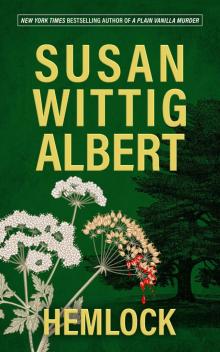 Hemlock
Hemlock Chile Death
Chile Death The Tale of Briar Bank
The Tale of Briar Bank Widow's Tears
Widow's Tears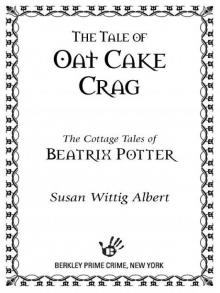 The Tale of Oat Cake Crag
The Tale of Oat Cake Crag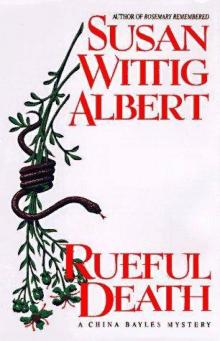 Rueful Death
Rueful Death Bittersweet
Bittersweet The Darling Dahlias and the Poinsettia Puzzle
The Darling Dahlias and the Poinsettia Puzzle A Wilder Rose: A Novel
A Wilder Rose: A Novel Spanish Dagger
Spanish Dagger The Darling Dahlias and the Texas Star
The Darling Dahlias and the Texas Star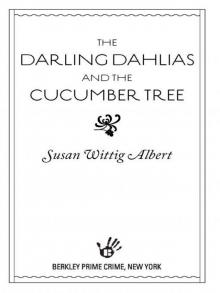 The Darling Dahlias and the Cucumber Tree
The Darling Dahlias and the Cucumber Tree China Bayles' Book of Days
China Bayles' Book of Days Death Come Quickly
Death Come Quickly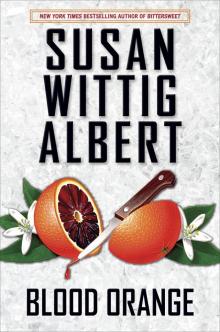 Blood Orange: A China Bayles Mystery
Blood Orange: A China Bayles Mystery Cat's Claw
Cat's Claw The Darling Dahlias and the Naked Ladies
The Darling Dahlias and the Naked Ladies The Tale of Hill Top Farm
The Tale of Hill Top Farm The Darling Dahlias and the Confederate Rose
The Darling Dahlias and the Confederate Rose The Darling Dahlias and the Silver Dollar Bush
The Darling Dahlias and the Silver Dollar Bush The General's Women
The General's Women Dead Man's Bones
Dead Man's Bones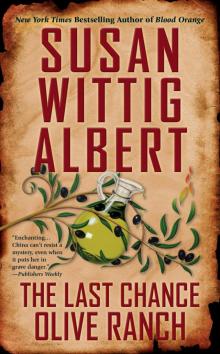 The Last Chance Olive Ranch
The Last Chance Olive Ranch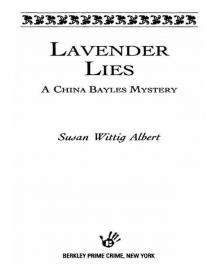 Lavender Lies
Lavender Lies The Tale of Hawthorn House
The Tale of Hawthorn House The Tale of Castle Cottage
The Tale of Castle Cottage Rosemary Remembered - China Bayles 04
Rosemary Remembered - China Bayles 04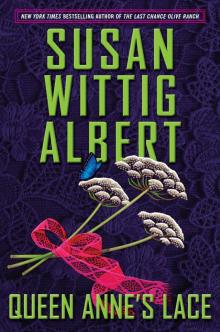 Queen Anne's Lace
Queen Anne's Lace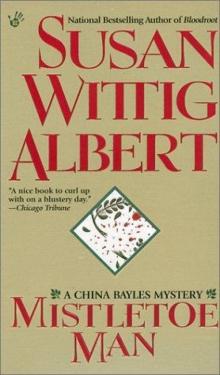 Mistletoe Man - China Bayles 09
Mistletoe Man - China Bayles 09 The Darling Dahlias and the Unlucky Clover
The Darling Dahlias and the Unlucky Clover Mourning Gloria
Mourning Gloria The Darling Dahlias and the Eleven O'Clock Lady
The Darling Dahlias and the Eleven O'Clock Lady